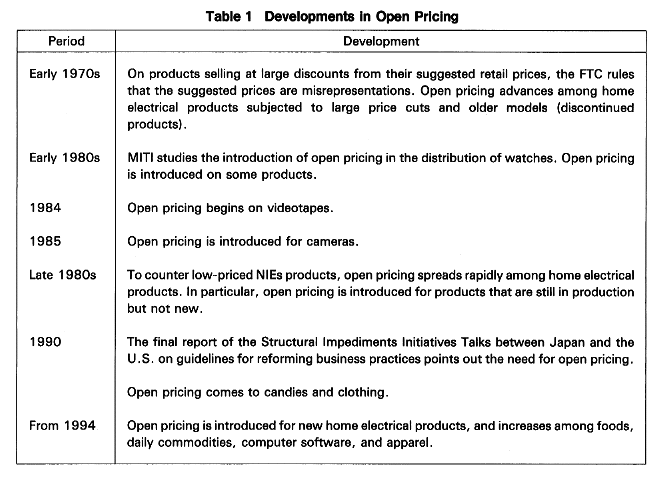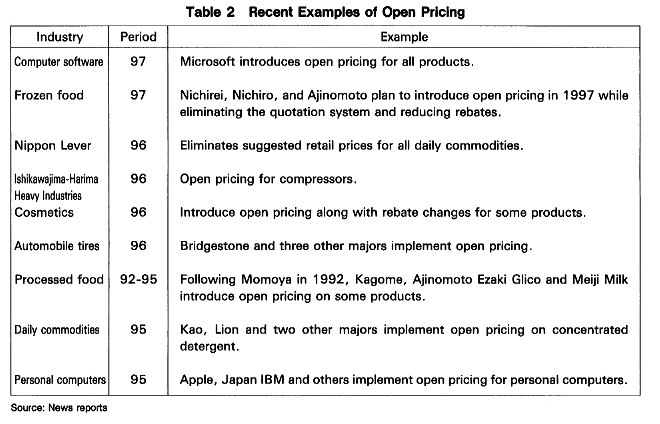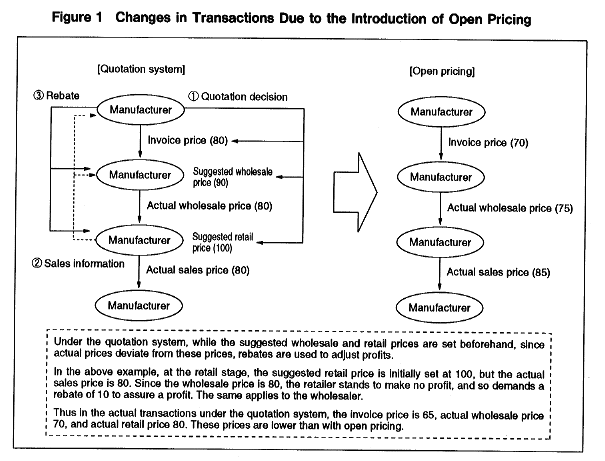- NLI Research Institute >
- The Growing Prevalence of Open Pricing in the Retail Sector
The Growing Prevalence of Open Pricing in the Retail Sector
Keisho Komoto
Font size
- S
- M
- L
| 1. Interest Mounts in Open Pricing
Attention has recently focused on the growing practice of "open pricing," in which manufacturers do not post a suggested retail price on their products. There are two reasons behind this interest. First, open pricing symbolizes a major shift in Japan's postwar distribution system, a system that has tried to discourage the entry of large retail stores, manufacturers organized wholesalers and retailers into "keiretsu," and used Japanese business practices such as the setting of manufacturer's "suggested retail prices." However, this system has changed significantly in recent years. The easing of distribution regulations and changing consumer lifestyles have encouraged the growth of large retailers, and the shifting balance of power among manufacturers, wholesalers and retailers has caused manufacturer-controlled distribution systems to loosen up. In addition, competition has intensified among retailers. Under the new arrangement, the inefficiencies of Japanese business practices have become particularly noticeable. Presently, there is a growing movement to build a new distribution system that corrects these inefficiencies and has been adapted to the changes. The practice of open pricing is an important element of this movement, and its progress is being scrutinized. Second, the impact of open pricing cannot be measured at present. Many manufacturers are adopting open pricing and at the same time abolishing or simplifying rebates to sellers to reduce sales promotion expenses while avoiding excessive price competition at the retail level. Open pricing has indeed led to the reevaluation of rebates and simplified transactions. However, the overall impact remains unclear, since most open pricing schemes do not go far enough in eliminating rebates. Results will gradually come to light as the practice develops further.
2. Open Pricing Gains Momentum in the 1990s Although attention has focused on open pricing in association with Japanese business practices only in the past few years, the practice itself dates as far back as the early 1970s (Table 1). A major social problem erupted when home electrical products were sold at big discounts over manufacturers' listed prices. When the Fair Trade Commission ruled that such listed prices constituted misleading representation, manufacturers turned to open pricing. However, only discontinued products became subject to open pricing at that time.
|

| In the early 1980s, open pricing was gradually adopted for products such as watches, cameras, and videotape, in large part because prices were dropping. By the late 1980s, the yen's surge and the growing competence of NIEs in production combined to generate a flow of low-cost, imported home electrical products comparable in quality to Japanese-made products. When prices consequently fell, the scope of open-priced products expanded to include home electrical products which, although not at the cutting edge, were currently in production.
In the 1990s, deregulation was accompanied by increased competition and price declines, open pricing spread rapidly beyond home electrical products to food, clothing, daily commodities and other products. In addition, even some new home electrical products were subject to open pricing. Table 2 contains specific examples of recent developments in open pricing. The growing scope of open pricing might be seen as a sign of the times. Previous attempts to resolve the disparity between suggested retail prices and actual prices had stopped at treating open pricing at the retail level, leaving intact practices such as rebates and listed prices. But recently there has been a tendency to approach open pricing as part of an overall reevaluation of the distribution system. Thus the era of genuine open pricing has finally just begun.
|

|
3. Price Copmpetition Leads to Open Pricing (1) The Functions of Suggested Retail Prices To understand the factors behind the emergence of open pricing, we must first look at why manufacturers post suggested retail prices. These prices have four functions.
1. Product quality indicatorSince manufacturers price their products in relation to the functions and quality of competitors' products, the suggested retail price signals to consumers a product's value. Surveys show that manufacturers are strongly aware of this (Table 3). Also, many consumers insist they cannot judge product quality without referring to the suggested retail price.
|

2. Sales promotionHaving consumers compare the suggested retail price with the actual price is an important marketing ploy. It helps sell products by convincing the consumer that the product is a bargain. In the 1970s and 1980s, a major reason that small and mid-sized retailers of home electrical products and watches sought open pricing from manufacturers was that large retailers were selling at large discounts from suggested retail prices.
3. Flexibility of transactionsThe combination of suggested retail price, listed price, and rebate systems allows for a flexible distribution system that can adapt to changes in supply and demand. When demand is difficult to predict at the retail level, transactions can be done at the time of shipment using listed prices based on the suggested retail price. If conditions change and prices fluctuate, it can be desirable to make adjustments post facto through rebates. For example, if retail sales fall below expectations, rebates may be an appropriate means to promote sales.
4. More profit for manufacturersIn areas where local retail competition is moderate and transportation is limited, consumers usually shop at the most convenient store. The retailer then enjoys monopoly power locally. If allowed complete freedom to set prices, the retailer will mark up prices above what the manufacturer desires, resulting in lower sales volume and less profit than expected to the manufacturer. Having a suggested retail price establishes a price ceiling, and enables the manufacturer to enjoy more profit. Consider the example in Table 4. Suppose the manufacturer's shipment price is 10 yen. Depending on whether the retail price is set at 15 or 20 yen, sales volume and profit to the retailer and manufacturer will vary. If allowed to set the retail price, the retailer will charge 20 yen (to enjoy a larger profit margin), leaving the manufacturer with a profit of 800 yen. But if there is a suggested retail price of 15 yen, the retailer cannot charge more than 15 yen; more units are sold, and the manufacturer earns 1,000 yen in profit.
|

| (2) Factors Encouraging Open Pricing
The recent advance of open pricing can be attributed to the fact that the functions of suggested retail prices have diminished due to changes in the economic environment. Four of these changes are described below.
1. Shorter product life cycleThe diversification of consumer tastes and rapid advances in technology have shortened product life cycles and sped up price declines. For example, it is not uncommon for personal computers to sell at a 40 to 50 percent discount from the suggested retail price just a few months after their release. Setting a suggested retail price on such products not only throws doubt on the reliability of the price as an indicator of quality, but also reduces the sales promotion effect. Also, changing the suggested retail price to avoid misrepresentations adds to the cost.
2. Higher store loyaltyAs retailers have matured and their merchandising power has grown, they have won greater confidence from consumers. Thus even if suggested retail prices disappear from price tags, consumers trust the price set by the retailer, and do not feel inconvenienced when judging product quality. What this increase in store loyalty means is that the sales price set by the retailer serves as an adequate signal of product quality.
3. Market saturation and faster information disseminationAs standards of living have risen and markets have matured, the replacement demand for home appliances and other products has outpaced new demand. In addition, new products of the caliber of a television or refrigerator appear infrequently; instead, familiar products are upgraded with new functions. Meanwhile, information on product features and prices has become readily available through magazines and other sources. These developments have heightened product awareness among consumers, thereby reducing the function of suggested retail prices as a product quality indicator, and also diluting the effectiveness of discounting suggested prices as a marketing ploy.
4. The changing competitive environment of retailingCompetitive conditions among retailers have changed drastically as deregulation, improvements in transportation, and changes in consumer purchasing behavior have favored large supermarkets over small retailers. Improved transportation and larger stores have expanded customer bases and intensified competition among retailers, who can no longer set prices with little regard for competitors. Thus even if retailers are allowed to set prices, they no longer pose the risk to manufacturers of exceeding prices desired by manufacturers. However, competition has exceeded the expectations of manufacturers, causing them to compete in reducing retail prices. Retailers relied on rebates from manufacturers to pursue price competition. As a result, rebate amounts requested by retailers increased, and manufacturers have become saddled with the problem of how to pay the extra rebates. Rebates, which manufacturers used to control, have transformed into funds which retailers use to independently pursue price reductions. Business practices such as suggested retail prices and rebates, which had provided flexibility when competition among retailers was lax, have become hindrances under rigorous competition.
4. Simplifying the Transaction System While the growth of open pricing practices has been aided by changes in the economic environment, it is also true that manufacturers have accelerated this trend by pursuing open pricing themselves. In introducing open pricing, their aim is also to reevaluate the rebate system and other business practices to simplify the transaction system and reduce sales promotion expenses. Under the old system, post-sale price adjustments not only complicate transactions, but induce price competition and cost an inordinate amount in rebates (Figure 1). Is open pricing proceeding as manufacturers have intended? At present, while considerable progress has been made in simplifying the rebate system, open pricing has yet to reduce sales promotion expenses. Although open pricing is reducing rebates by lowering invoice prices, rebates and quotations have not been totally eliminated due to demand from retailers to continue the rebates for sales promotion. On this point, the situation has not changed significantly from before open pricing was introduced. In the future, while we can expect rebates to be steadily simplified, as long as rebates remain effective in promoting sales, they are not likely to be completely eliminated. If we interpret the increase in rebates under the existing framework as a sign of greater pricing power among retailers, we can imply that the impact of any changes in transaction forms on actual transactions will be quite limited.
|

|
5. Progress of Open Pricing Will be Moderate The open pricing trend will persist because of ongoing changes in the economic environment, and the growing demand from foreign retailers in Japan for more transparent transaction practices. However, we do not expect its rapid implementation across all products. For one thing, a substantial number of manufacturers and consumers favor the continued use of suggested retail prices as an indicator of product quality. Also, the benefits of open pricing have not yet been fully shown. Instead, open pricing is most likely to be implemented in products experiencing distribution system problems such as complex rebate systems and sharp deviations from suggested retail prices. And alongside the progress of open pricing, we expect to see the reevaluation of current business practices such as rebates and quotations, and the simplification of transaction systems.
|
Keisho Komoto
Research field

















